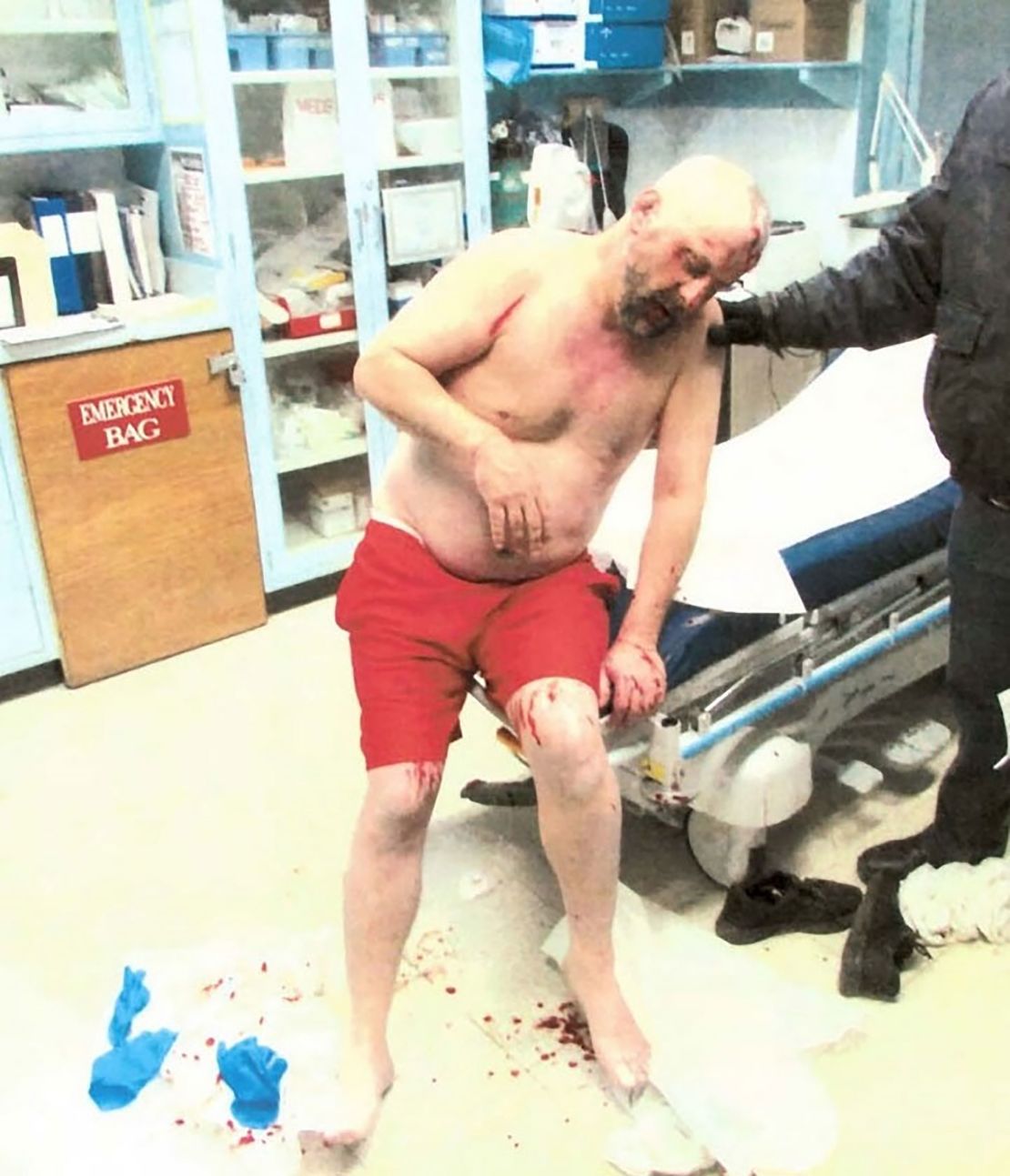CNN
—
The beating and death of an inmate at a New York prison last month has sparked a firestorm of criticism over the violence and brutality some inmates experience at the hands of corrections officers.
But inside Marcy Correctional Facility, the news of Robert Brooks’ death – while undeniably tragic – did not come as a complete shock, one inmate told CNN.
Frederick Williams, 30, told CNN he transferred to Marcy in November because he wanted to participate in the prison’s substance abuse treatment program.
But in the short time since he arrived, Williams said, he’s had several encounters with the prison’s corrections officers who he alleges have used physical violence and the threat of retaliation to get him to comply with their demands.
Brooks’ death, he said, has encouraged him to speak out publicly for those who cannot or will not.
“I have been thrown against the wall, head smashed against the wall, as well as rib shots that have bruised my ribs – our freedom in life has been threatened,” said Williams, who is serving a 3.5-year sentence on a gun charge.
Williams told CNN both he and his family have attempted to file reports with the Office of Special Investigations at the state’s Department of Corrections and Community Supervision, but he doesn’t have much hope that things will change.
“This Marcy Correctional Facility is run by a mob,” he said.
CNN provided the DOCCS with the case numbers for Williams’ complaints and a department spokesperson responded Tuesday, confirming Williams has been interviewed by an OSI investigator and that the review of his case is ongoing.

Since Brooks’ death, New York Gov. Kathy Hochul has announced she will appoint a new superintendent at the prison. The state corrections department has also named 14 staff connected to Brooks’ death; as of December 31, none of the officers has been charged with wrongdoing.
Experts and attorneys who spoke to CNN said over the years, Marcy Correctional Facility has developed a reputation for being a place where inmates often experienced violence, intimidation and racism at the hands of staff.
Jennifer Scaife, executive director of Correctional Association of New York (CANY) – the independent ombudsman tasked with monitoring the state’s 42 correctional facilities – told CNN she’s confident any investigation into the prison would reveal the attack on Brooks was “not an aberration.”
“It’s really been a facility that we’ve heard a lot of very troubling allegations out of for quite some time,” she said. “I think what will be shown … is a pattern and practice of brutality and violations of people’s human and civil rights.”
A promising start gives way to ‘rampant abuse’
The Marcy Correctional Facility opened in 1988 as an all-male medium-security facility and one of three prisons in New York’s Oneida County, a little more than 50 miles east of Syracuse.
The prison was among the first in the state to launch a Comprehensive Alcohol and Substance Abuse Treatment program, which offers individuals a path to recovery while incarcerated. Those who participate in the program at Marcy may be provided treatment, opportunities for community reintegration through a work release program, and after care while on parole.
In 2002, CANY published a report on conditions at Marcy, noting the facility has “ranch-style brick buildings and paved sidewalks to accommodate approximately 200 wheelchair-bound inmates.”
After completing one tour of the prison in 1998, auditors concluded “Marcy is generally a well-run prison with adequate opportunities for inmates to make constructive use of their time.”
Decades later, CANY’s perception drastically changed.
In 2022, after receiving numerous letters from inmates at the prison, auditors returned to Marcy to investigate the conditions.
Following the audit, the organization sounded an alarm in a scathing report that found inmates reported “rampant abuse by staff including physical assaults and observations of a retaliatory environment.”
Inmates told the auditors the alleged assaults often occurred in “locations where cameras are absent including between the gates, in vans, and in showers,” according to the report.
Many officers, the report noted, did not wear body cameras and “a reason was not provided” by the prison’s executive team.
Sixty-seven percent of inmates interviewed by CANY monitors said they’d seen or experienced race-based violence from staff – an incidence, the report noted, that was much higher than other facilities in the state.
“The CO told me when I got here this is a ‘hands-on facility,’ we’re going to put hands on you if we don’t like what you’re doing,” the report says one inmate told auditors.
Another said, “Vibes in this jail with staff are off – they brag and intimidate us about the number of people they’ve beat or sprayed.”




Scaife said she was stunned by how openly the correction officers seemed to talk about the violence at the facility, according to the inmates.
“This kind of culture of abuse, violence and impunity has really festered,” she said, adding, “I think that kind of culture of impunity exists at prisons across the state of New York.”
CANY recommended the Office of Special Investigations and the state’s Inspector General investigate the “widespread claims of abuse at Marcy and make the findings and measures taken to address them” public.
Following Brooks’ death, CNN asked the Department of Corrections and Community Supervision how it has responded to the 2022 CANY report and its allegations. In a statement, the department said it opened four investigations into the physical assault allegations described in the report.
Three of the cases were “unsubstantiated following a thorough investigation,” according to the statement, and the fourth was referred outside of the facility.
“We have addressed or are in the process of addressing the majority of the recommendations contained in the 2022 CANY report,” the department said in the statement.
“Body-worn cameras were deployed to Marcy Correctional Facility in May 2024. Those cameras were critical in preserving the evidence of the fatal attack of Mr. Brooks.”
Other cases in the courts
But for some, the changes and body cameras were too little, too late. In 2022, the family of Lonnie Hamilton, a former inmate at Marcy prison, was awarded $1.5 million in damages after a court found the state failed to meet its duty of care to prevent Hamilton’s suicide.
Hamilton’s family was not notified of his death – or that staff buried him on prison grounds – until months after he died, according to a statement from the family’s attorney.
The same year, two former inmates filed separate lawsuits against corrections officers at Marcy for alleged attacks they say they experienced while incarcerated.
One of the inmates, Adam Bauer, was incarcerated at Marcy for a nonviolent drug offense and had less than a year left on his sentence when four officers attacked him in a bathroom in February 2020, according to a lawsuit.
Bauer was thrown to the ground, punched in the head and kicked repeatedly in the side, his lawsuit states.
“One of the sergeants present hit (Bauer) over the head with a clipboard so hard that the metal clasp on the clipboard left a V-shaped gash in (his) forehead,” the lawsuit states.
Bauer’s attorney, Katherine Rosenfeld, told CNN he was later taken to the same infirmary where Brooks was beaten to death.
“He had never experienced anything like this in his life. He was just savagely and randomly beaten,” she said. “He was alone in a bathroom with a bunch of correction officers kicking and punching him on the ground and he thought he was going to be killed.”




Photos of the injuries included in the lawsuit show Bauer was bloodied and dazed following the incident.
After being told to change out of his blood-stained clothes, Bauer was taken to a local emergency room, where correctional staff told a nurse his injuries were self-inflicted and “occurred by a seatbelt,” according to the lawsuit. Other officers told hospital staff the injuries were caused by “another inmate.”
The wound on his head required more than 20 stitches, the lawsuit states.
In a court filing in response to Bauer’s lawsuit, the defendants denied “each and every allegation” and denied they violated any laws. They said Bauer is not entitled to any relief, and they demanded a jury trial.
Bauer’s lawsuit says that as a result of the incident and the disciplinary proceeding that followed, he was removed from the substance abuse treatment program and sentenced to 90 days in solitary confinement.
Months later, Rosenfeld said, Prisoner Legal Services appealed that decision, and the Department of Corrections and Community Supervision informed Bauer the ruling had been reversed. He was released from “keeplock” but continued to serve out the rest of his sentence.
Rosenfeld said a family member visited Bauer at Marcy, noticed his injuries and began seeking legal help from her firm, Emery Celli, LLP, which specializes in providing legal counsel for inmates in New York jails and prisons.
Bauer’s case is currently awaiting a trial date. Though years have passed, Rosenfeld said the attack still has a profound effect on her client.
“I think he feels lucky to be alive, and I think he hopes that, you know, this is going to make some contribution towards stopping this type of violence going on in the future.”
Change of culture needed, ombudsman says
In the wake of Brooks’ death, Hochul vowed to expedite changes to the state’s entire corrections institution, including purchasing and enforcing the use of body cameras and adding staff to the Office of Special Investigations.
The state has also earmarked more funding for CANY to continue its oversight functions. But Scaife said lasting change won’t come from increasing funding and adding cameras alone.
“In order to prevent the kind of violence and contempt for human life that made this incident possible there really has to be a concerted long-term commitment to changing the culture of corrections that so that it focuses on people’s humanity,” she said, adding this also includes recognizing that corrections staff work in difficult circumstances.
“They need opportunities to observe the humanity of incarcerated people and have their own humanity recognized – it’s no quick fix solution.”
Until then, Williams said, he hopes other inmates will continue to speak out for Brooks and others who are afraid to raise their voice.
“One day you speak and may save other lives before it is too late,” he said. “We need to set an example for those who abuse their power and authority.”
This post was originally published on this site be sure to check out more of their content.








